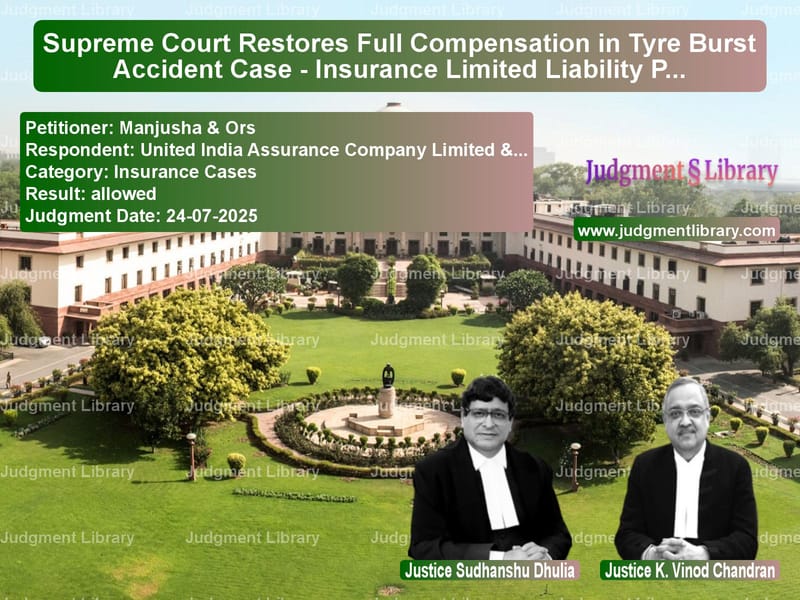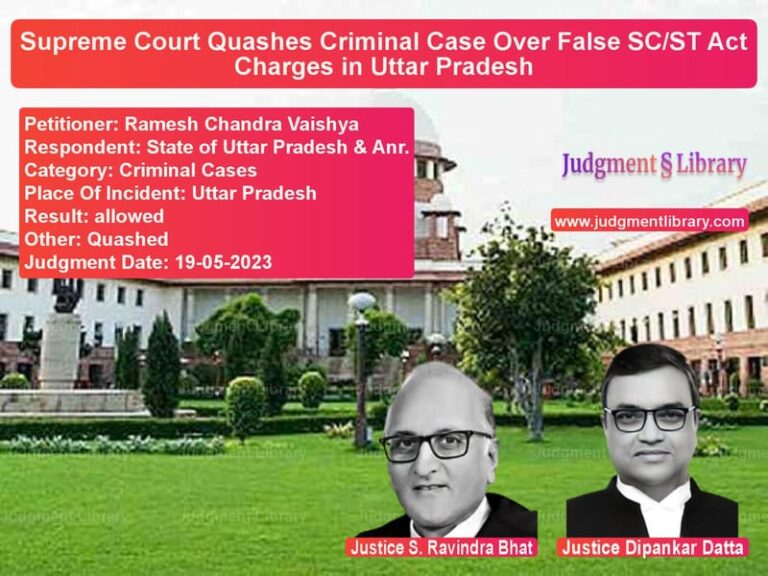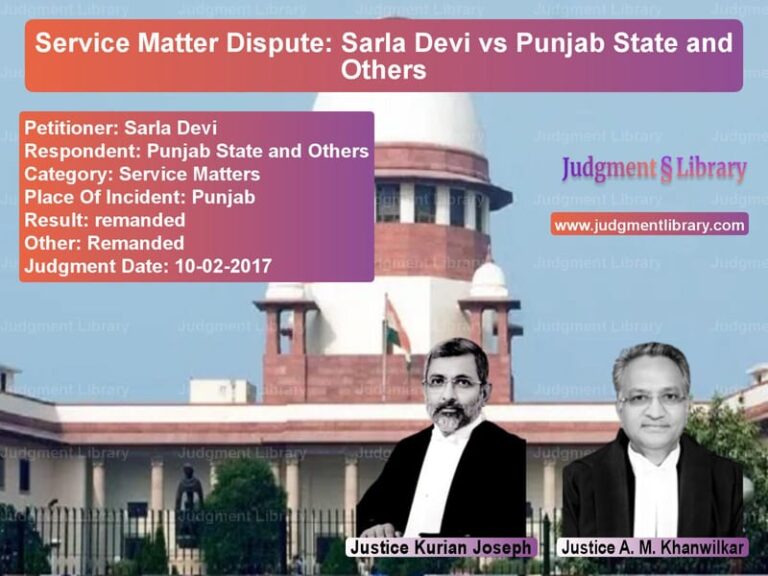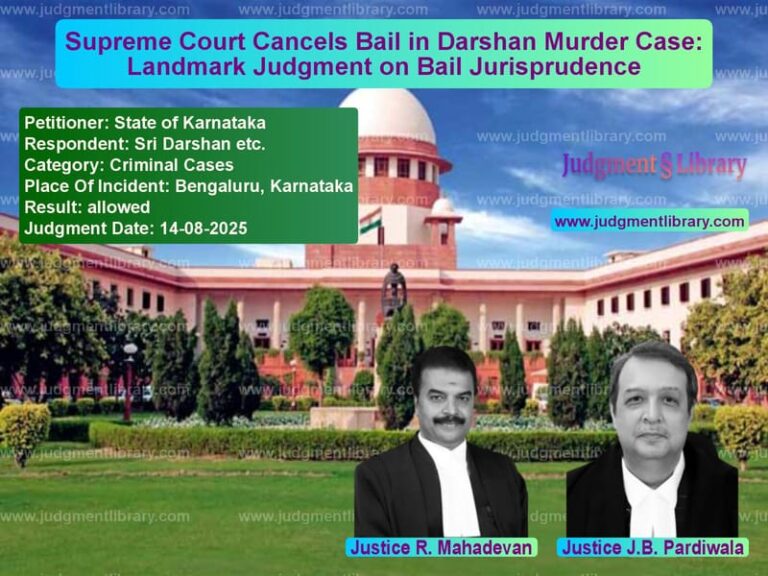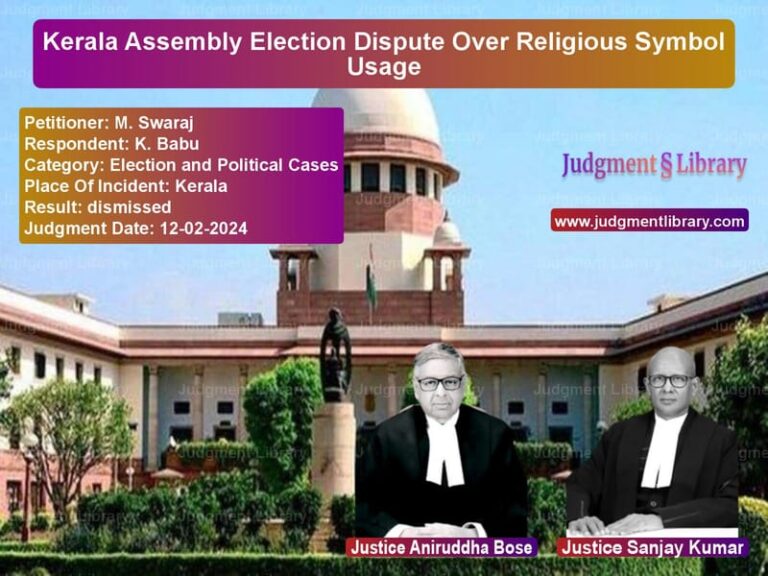Supreme Court Restores Full Compensation in Tyre Burst Accident Case – Insurance Limited Liability Plea Rejected
In a significant ruling that reinforces the importance of proper pleadings and evidence in insurance claims, the Supreme Court of India has restored full compensation to the family of a man who died in a tragic accident caused by a tyre burst. The judgment, delivered on July 25, 2025, marks a crucial interpretation of insurance contract liabilities and the procedural requirements for insurance companies to claim limited liability.
The case involved a heartbreaking tragedy where a family trip turned fatal due to a sudden tyre failure. The appellants, Manjusha and others, who are the widow, minor children, and parents of the deceased, had approached the courts seeking compensation after the family’s breadwinner died in a tragic accident. The deceased was driving a car when the right rear tyre burst, causing the vehicle to go out of control, topple, and resulting in fatal head injuries to the driver.
The factual background reveals that the deceased and the vehicle owner, who were brothers, were travelling along with their families when the accident occurred. The car was being driven safely at moderate speed with due diligence and caution when the tyre burst unexpectedly. The owner of the vehicle, his wife, and the wife of the deceased all sustained injuries in the same accident, making it a family tragedy of immense proportions.
When the claimants approached the Motor Accident Claims Tribunal, they were granted compensation of Rs. 25,82,000 based on the income of the deceased and various other heads including transportation, loss of consortium, travelling, and funeral expenses. The Tribunal found that the vehicle was covered by a comprehensive policy wherein premium for personal accident to owner-cum-driver was paid, establishing insurance coverage for the incident.
However, the United India Assurance Company Limited filed an appeal before the High Court, primarily on the grounds that there was negligence on the part of the driver, thus absolving the insurer from liability since the driver, who steps into the shoes of the owner, is the tortfeasor. The insurance company’s arguments centered around the statutory liability restrictions and alleged breach of policy conditions.
The High Court took a different view and examined the insurance policy, finding no case for imposing statutory liability but discovering that the comprehensive policy with additional premium covered only limited liability to the extent of Rs. 2,00,000 for injury/death caused to the owner/driver. Based on this interpretation, the High Court drastically reduced the insurance company’s liability from the full compensation amount to merely Rs. 2,00,000.
This reduction prompted the claimants to approach the Supreme Court, setting the stage for a crucial examination of insurance contract interpretation and procedural requirements in compensation claims.
Before the Supreme Court, Mr. Amit Kumar Singh, learned Counsel for the respondent-insurance company, relied on a number of decisions to substantiate the insurance company’s claim. He argued that the guidelines of the insurance company clearly indicated the limited liability insofar as the policy taken by the insurer, the owner of the vehicle. The insurance company placed reliance on various judicial precedents to support their contention of restricted liability.
However, the learned Counsel for the claimants contended that such a ground of limited liability was never taken before the Tribunal or before the High Court. He pointed out that the guidelines were never produced in evidence nor was any witness examined on the part of the insurance company. The claimant had mounted the box, but no cross-examination was addressed upon the contentions now raised regarding limited liability.
The Supreme Court, in its detailed analysis, first examined the legal precedents cited by the insurance company. The Court referred to Oriental Insurance Co. Ltd. v. Rajni Devi, which arose from a claim on the death of a person riding a motorcycle, where the insurance company resisted the claim contending that although the owner of the vehicle deposited an extra amount covering his personal insurance, the same would not cover the case of the pillion rider.
The Court also considered Oriental Insurance Co. Ltd. v. Jhuma Saha, where the owner of the vehicle himself was to be blamed for the accident, and it was held that under Section 166 of the MV Act, the insured itself cannot be fastened with any liability giving rise to no question of the insurer indemnifying the insured.
In Dhanraj v. New India Assurance Co. Ltd. & Anr., the Court found that Section 147 of the MV Act does not require an insurance company to assume risk for death or bodily injury to the owner of the vehicle. The comprehensive policy taken therein assured a premium having been paid under own damage, which was found to cover only the liability arising from damage caused to the vehicle and non-electrical accessories and not the injury caused to the owner itself.
The Supreme Court also examined Ramkhiladi v United India Insurance Co., Ningamma v. United India Insurance Co. Ltd. and New India Assurance Co. Ltd. v. Sadanand Mukhi, which were all cases under Section 163A of the MV Act, where it was held that a borrower of a vehicle, who was driving, cannot raise a claim under no fault liability, since the driver of the vehicle steps into the shoes of the owner.
However, the Supreme Court made a crucial distinction in the present case. The Court observed that “these are all cases with respect to the statutory liability, and we have to emphasise the personal accident insurance cover, highlighted in one of the above cited decisions, which is relevant here. What assumes significance in the present case is that it is not the statutory liability, but the contractual liability of a personal accident cover which forms the basis of the claim raised.”
The Court noted that “admittedly, there was a personal accident cover taken. The question is only as to whether the liability was limited or not. As we noticed, neither the insurance policy is before us nor do we see a contention of limited liability having been taken, from the order of the Tribunal which notices the contentions taken in the written statement.”
This became the cornerstone of the Supreme Court’s decision. The Court examined the procedural history and found that “the written statement as we observed has not been produced in the records of the case. However, we have the benefit of the memorandum of appeal filed before the High Court by the insurance company which is produced as Annexure P2. We do not see any such ground of a limited liability having been taken. The grounds taken from 1-8 are all with respect to the negligence of the driver and absence of a valid and effective driving licence.”
The Supreme Court strongly criticized the High Court’s approach, stating that “when the contention of limited liability was neither taken before the Tribunal nor even in the memorandum of appeal filed, there was no reason for the High Court to look into the policy document to find limited liability.”
The insurance company had urged before the Supreme Court based on an extract of the Indian Motor Tariffs, termed to be a guideline issued by the Tariff Advisory Committee. The Court acknowledged that “by the guidelines it is intended that a comprehensive regulatory framework governing the structure, terms, conditions and premium rates applicable to Motor Vehicle policies in India is created. It is stated that the IMT is binding on all general insurance companies, operating in the Country and ensures uniformity and fairness in underwriting motor insurance risk.”
However, the Court made a crucial qualification: “No doubt, the guidelines issued by the Tariff Advisory Committee regulates the issuance of the policies by the insurers but unless it is specified in the insurance policy, it cannot bind the insured.”
The Court specifically referred to IMT 16 which has the nominal heading ‘personal accident to unnamed passengers other than insured and paid driver and the cleaner’, which is stated to be limited to the amounts specified therein. The Court noted that “under IMT 16, there is a tabular form which enables 100% compensation with respect to various injuries inter alia of death. It is in the proviso that there is a limit provided with specification that the Capital Sum Insured (CSI) per person is to be inserted.”
The Court emphasized that “whether such sum was inserted in the policy and whether such a contention was taken before the Tribunal is most relevant in the adjudication of the instant case.”
In this context, the Supreme Court referred to Ramkhiladi, where there was a contention taken by the claimant that the deceased was employed by the owner of the vehicle. It was held that no evidence was led by the claimants to prove that the deceased driver was an employee of the owner. The Court underscored the fundamental principle of adjudication: “Pleadings and proof of such pleadings; by valid evidence led, is the crux and core of any adjudicatory process. Trite is the principle that there can be no proof offered without specific pleadings.”
The Court concluded decisively: “The limited liability was not pleaded, by the insurance company, either before the Tribunal, as we see from the award made, nor in the appeal filed before the High Court as we see from the memorandum of appeal filed before the High Court.”
Based on this fundamental procedural lapse, the Supreme Court “found absolutely no reason to sustain the High Court order, which we set aside.” The Court restored the order of the Tribunal and directed that “the amounts awarded to be paid within a period of two months from today with interest @ 8% per annum as ordered by the Tribunal and whatever amounts have already been paid shall be deducted.”
The Court also directed that “the appellant shall provide the bank account details to the Insurance Company who shall transfer the amount online within the period specified hereinabove.”
This judgment represents a significant reinforcement of procedural discipline in insurance litigation. By insisting that insurance companies must specifically plead and prove their defenses, including limitations of liability, at the appropriate stage of proceedings, the Supreme Court has protected the rights of accident victims against last-minute technical defenses.
The ruling also clarifies the distinction between statutory liability under the Motor Vehicles Act and contractual liability under personal accident covers in comprehensive insurance policies. While statutory liability may be restricted, contractual liability depends on the specific terms of the policy and proper disclosure of those terms to the insured.
Furthermore, the judgment emphasizes that internal guidelines and tariff provisions, while binding on insurance companies, cannot automatically limit liability unless specifically incorporated into the insurance policy and properly communicated to the policyholder. This ensures transparency and fairness in insurance contracts, preventing insurance companies from relying on internal documents that are not shared with customers.
The Supreme Court’s approach in this case demonstrates a balanced interpretation that protects consumer rights while acknowledging the legitimate business interests of insurance companies. By requiring proper pleadings and evidence for defenses, the Court has ensured that the legal process remains fair and predictable for all parties involved.
This judgment serves as an important precedent for similar cases where insurance companies attempt to limit their liability based on technical grounds that were not properly raised during initial proceedings. It reinforces the principle that courts should not suo motu investigate defenses that the parties themselves did not raise at the appropriate stage.
In conclusion, the Supreme Court’s judgment in Manjusha’s case represents a significant victory for accident victims and a reinforcement of procedural integrity in insurance litigation. The ruling ensures that insurance companies cannot spring surprise defenses at appellate stages but must clearly state their positions from the beginning, allowing claimants a fair opportunity to counter them. This approach not only delivers justice in the individual case but also strengthens the entire ecosystem of accident claims and insurance litigation in India.
Petitioner Name: Manjusha & Ors.Respondent Name: United India Assurance Company Limited & Anr.Judgment By: Justice Sudhanshu Dhulia, Justice K. Vinod Chandran.Judgment Date: 24-07-2025.Result: allowed.
Don’t miss out on the full details! Download the complete judgment in PDF format below and gain valuable insights instantly!
Download Judgment: manjusha-&-ors-vs-united-india-assuran-supreme-court-of-india-judgment-dated-24-07-2025.pdf
Directly Download Judgment: Directly download this Judgment
See all petitions in Motor Insurance Settlements
See all petitions in Insurance Settlements
See all petitions in Compensation Disputes
See all petitions in Road Accident Cases
See all petitions in Judgment by Sudhanshu Dhulia
See all petitions in Judgment by K. Vinod Chandran
See all petitions in allowed
See all petitions in supreme court of India judgments July 2025
See all petitions in 2025 judgments
See all posts in Insurance Cases Category
See all allowed petitions in Insurance Cases Category
See all Dismissed petitions in Insurance Cases Category
See all partially allowed petitions in Insurance Cases Category

